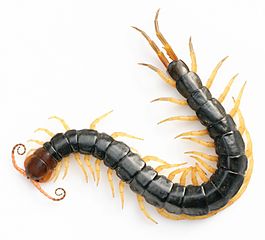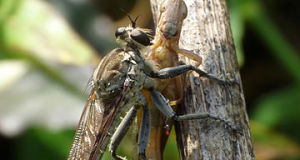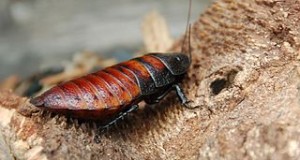The serious centipede enthusiast can look forward to a lifetime of interest and discovery. Over 3,000 species (class Chilopoda) have been described so far, and we know little about most! Biologists place Centipedes and the world’s 10,000+Millipedes in the same Super Order, Myriapoda, but any similarities end there. The name “Giant Centipede” is applied to a variety of species. Those most commonly seen in trade are the Amazonian Giant Centipede (Scolopendra gigantean) and the Vietnamese or Red-headed Centipede (S. subspinipes), but as many as 6 species have been recorded as being sold under the same name.
Centipede ownership requires consideration, and should only be undertaken by mature, cautious adults. Bites from various species have caused fevers, dizziness, cardiac problems, breathing difficulties and fatalities. Allergic reactions to their venom can occur – as evidenced by a Bronx Zoo co-worker of mine, who was hospitalized after being bitten by a species considered to be harmless.
The following information can be applied to then the care of most commonly available centipedes. Please post below for information on individual species.
Natural History
Centipedes are found on all continents except Antarctica, and live in varied habitats, including deserts, grasslands, caves, temperate woodlands, rainforests and human dwellings. The true giants are confined to tropical regions.
All are voracious predators, with larger species sometimes taking bats, tarantulas, rodents and other sizable animals; please see this article for further information. When attacked, Centipedes release irritating secretions and can inflict wounds with their fangs (which are actually modified legs connected to venom glands) and pointed rear legs.
Centipedes have 15-30 pairs of legs. The Amazonian Giant Centipede, Scolopendra gigantea, is the largest species; females may top 12 inches in length.
The Terrarium
Centipedes may be kept in screen-covered aquariums, but bear in mind that they are escape artists that can exert a tremendous amount of pressure and are able squeeze through impossibly-tiny openings. Their terrarium’s cover must be secured by 6-8 clips. Gallon jars with screw-on tops are an escape proof option. I do not recommend plastic terrariums with clip-on tops. Please see this article to read about an escape that occurred during my tenure at the Bronx Zoo.
Plastic caves, a deep substrate and cork bark shelters should be provided.
“Ant farm” style set-ups may allow you to watch your pets’ below-ground activities. A small aquarium placed upside down within a larger one will confine their burrowing activities to the area along the glass; please see article linked below.
Substrate
The substrate should be 4-6 inches deep and comprised of coconut husk, peat moss and top soil. Plain coconut husk, as well as leaf litter and decaying wood, have also been used with success.
Light
Red/black reptile night bulbs will allow you to watch your pets’ nocturnal activities.
Heat
Most do well at temperatures of 72-85 F; please post below for individual species’ details.
Red/black reptile night bulbs, ceramic heaters or heat pads can be used to warm the terrarium. All have a drying effect, so be sure to monitor humidity.
Humidity
Centipedes are prone to dehydration and require humidity levels of approximately 75%. Humidity can be increased by misting, moistening the substrate, and partially covering the lid with plastic. Reptile misters and humidity gauges are useful in arid surroundings.
Companions
Centipedes are “pathologically unsociable” and must be housed alone.
Feeding
Centipedes will thrive on a diet of crickets, roaches and earthworms. Wild-caught insects may be offered to help balance the diet. They will also accept canned grasshoppers and snails via tongs, but be extremely careful when feeding in this manner. Mice are not required, even for the largest species.
Powdering food once weekly with a reptile vitamin/mineral supplement may be beneficial.
Centipedes obtain water from their food, but should be provided with a shallow water bowl.
Daily Care and Maintenance
Centipedes remain below ground when molting, at which time high humidity levels are especially important.
Tiny white mites are often introduced to terrariums via substrate or food. Most are harmless scavengers that can be lured into a jar baited with fish flakes. Please see the article linked below for further information.
Long-handled tongs – never fingers – should be used to remove uneaten food and water bowls from Centipede terrariums.
Health Considerations
Centipedes are fast-moving and high strung, and will strike at any disturbance or vibration. Please ignore the ridiculous online videos showing people handling Giant Centipedes.
Centipede bites have caused fevers, dizziness, cardiac problems, breathing difficulties and fatalities. Before keeping Centipedes, discuss the matter with your physician and make certain that treatment will be available if needed. Be sure to explain that species identification may be impossible (i.e.6 species have been sold under a single trade name, and some species exhibit an array of different colors).
Further Reading
Terrariums for Burrowing Invertebrates
Millipede Care and Natural History
Mites in Invertebrate Terrariums
 That Reptile Blog – Reptile, Amphibian and Exotic Pet Care and Information
That Reptile Blog – Reptile, Amphibian and Exotic Pet Care and Information






When I was a kid I’d love looking under rocks and finding bugs, but quickly learned that centipedes were NOT fun to play with. Didn’t like getting bit by them.
Same here, Paul..in fact I’m still poking under rocks and having fun! Even smaller species can break the skin, but lots to observe,….within last 10 yrs or so, a new species of centipede was discovered in Central park, and there’s many more out there unseen for sure, Best, frank
just godda say thank you for all this info I just got a haitian giant centipede and was wondering why he was spending so much time under the ground but now I know hes molting/shedding again thankyou
Hi Joseph,
Thanks for taking the time to write in, glad the info is useful to you. Take care to keep the terrarium moist, as they are prone to dessication at this time. Please let me know if you need anything, a happy and healthy new year to you and yours, Frank
just wondering how offtin should I spray his terarium to keep it at about 75% humidity? and how much heat?
Hello,
Misting will depend upon what type of heat you are using (bulbs and ceramic heaters tend to dry out the substrate), the ambient humidity of the room, depth of substrate etc. It’s generally fine if you keep the substrate slightly moist and provide a cave stocked with damp sphagnum as a retreat. If you want to measure exactly, you can use a small hygrometer..
The temperature can range from 75-85 F, with an average of 78-80 being fine.
Best, Frank
cuz the people at the reptile shop told me to use a 50 watt bulb with a small lamp so on payday I will go and get a hygrometer so I can keep the little guy healthy and happy and again thank you so much for all this info
Hi Joseph,
My pleasure; it’s difficult to make recommendations concerning bulb size etc as there are so many variables. Use a small aquarium thermometer to check the temperature so that you’ll know if the 50 wt is enough, too much, etc. You can see some options here, best, Frank
Hi Frank , I just caught a centipede , bt I am only a amateur. I just make it a simple home cauz I am only a student n have no much money to buy anything for it . It’s ok if I only put in a layer of soil n a small dish of water for it ?
Hello,
Most do fine with soil, a piece of bark etc to hide under…no need for water dish, just mist with a spray bottle each 1-2 days, feed crickets etc….do not handle, and be sure lid is tight with no spaces for escape. Not sure where you are located, but some species are dangerously venomous, and people may have allergic reactions to bites of any species..not the best animal to start with if you do not have experience, let me know if you need more info, best, frank
Cauz I’m feeding spiders for many years , so I decide to change try to raise centipede. It’s the layers of soil need to be very , cauz mine only a very thin layer of soil , n for the food, beside the cricket , can I feed it by the kind of worn that can buy from fish shop ( yellow colour one , dunno wat its name == )
Frank , did u have fb , cauz I would like to send u some pic of my centipede for u and ask for some guild , thanks ^^
Hi Dylan,
As long as soil stays moist and it has something to hide beneath, should be fine. mealworms may be too tough for it, as they have a thick exoskeleton. You can post photo on FB, but ID will likely be difficult as there are thousands of very similar species; let me know where collected also: https://www.facebook.com/frank.indiviglio.9
Hi Frank , my centipede is only about 5cm long , ist a cricket that about 4cm long will be too big for it as food ?
Hello, it would be best to offer smaller food items..large insects may be seen as a threat, Please let me know if you need more info, frank
Hi Frank , I nid more info about its food , I put cricket inside , bt it attack my centipede, my centipede run all over the box == I already dunno watt to feed it , nid ur advice frank
Hello,
It may be that the insects are too large, or that the centipede is stressed by captivity…something in the environment is lacking, etc. Also, some species are specialists, taking only certain types of prey. Without knowing the species and it’s needs, it will be difficult to keep…when well adjusted, they feed readily. Perhaps best to release and seek a captive bred specimen of a known species, best, frank
it’s hard to find a centipede , I have been find for many week still can’t find even one small centipede, this centipede is found in very lucky condition, when I bath , it came out . Frank , if I send u the pic of my centipede, can u know wat species it’s ? Or do u have any method to find a centipede , thanks ~
Hello,
I checked the photo on FB but am not able to ID the species..as mentioned, there are thousands that are similar and cannot be distinguished by appearance alone. Centipedes are generally found in moist areas under rocks, logs and and other shelters, but exact habitats vary widely, best regards, frank
Hi Frank,
I might buy a Vietnamese centipede and I was wondering if a plastic tub would be a suitable terrarium. The tub has a lid, but should I poke holes in the lid for ventilation?
Hi there,
We often get Vietnamese centipedes here at our store, and I personally kept one for a while. I have always preferred this style enclosure for them. It is made from harder plastic than the other “critter keeper” style, and has a lip that goes all of the way around the top. Although some people do, I definitely would not use a plastic tub, the material is too soft. I have seen centipedes chew through the air holes and escape within minutes.
Be careful. As Frank mentions in his article, centipedes
can beare very dangerous. They are incredibly fast and don’t hesitate to bite. Vietnamese centipede bites have caused human deaths, and even “mild” bites can cause tissue damage and symptoms that could last for days.As far as feeding goes, they will eat anything that they can overpower. Three to four appropriately sized crickets should be adequate to feed one for a week.
Take care,
-Josh
Can tarantulas bite through thin plastic as well?
It would be very unlikely that a tarantula would bite through plastic. Centipedes mouth parts are meant for chewing and tearing, where as tarantulas are not.
Are there any giant centipedes that are not very venomous? I don’t want to own an insect that can kill me.
Unfortunately, all of the giant centipedes are pretty venomous. Some are worse than others, but all have the potential to cause serious side effects. Have you considered an African giant Millipede? They get quite large, are herbivores, and very docile.
How much should I feed a Vietnamese centipede? Will a few store bought crickets a day be enough?
Hi Frank,
I’ve had a Vietnamese centipede for just over a year now and she usually keeps to herself under the water dish but will come out for food and sometimes just to explore around night time. Besides that it seems unusual to see her out and about for any longer. In the last 2 weeks or so I’ve noticed her out at random times during the day and she seems to be cleaning herself a lot when she’s out. It almost seems like she has an itch she can’t scratch and will constantly turn the lower half of her body side ways and clean the underside. I’ve never seen this happen before but she’s doing it so often now and I think maybe she was getting ready to molt, however like I mentioned she’s out a lot even and not very active. She’ll even go under her water dish but leave her head sticking out or the lower half of her body. She’s walked over her food and completely ignore it so I assume she’s not hungry. I’m a first time centipede owner and I’ve done lots of research but nothing’s been able to give me the information in looking for. I really hope she’s not dying and that you might be able to give me some information about this.
I have a 10 gallon aquarium and I want to make it a habitat for semi-aquatic newts. I have the substrate, peat moss, live plants, and lots of hiding places. I don’t know what type of filter to use, is tap water okay to use or do I need to treat it, how much water I should put in the water side, what semi-aquatic newts are the best to get & where can I get them. Basically I need to know how to set up my tank since I am new at this.